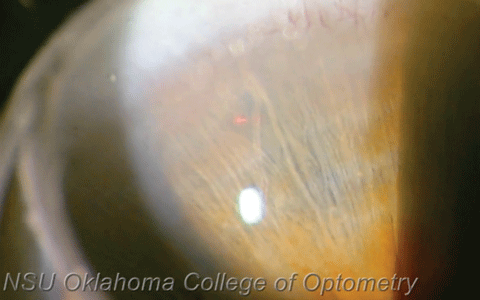 |
|
Researchers suggest that the increased angle widening associated with superior LPIs could be a culprit behind increased risk for visual symptoms. Photo: Joseph Shetler O,D, and Nathan Lighthizer, OD. Click image to enlarge. |
A laser peripheral iridotomy (LPI) is employed in primary angle-closure glaucoma and other procedures to relieve pupillary block. Though uncommon, some patients with this small hole in the iris report unwanted visual phenomena such as glare, halo, ghost image and shadows. It’s not clear what causes these dysphotopsias, but their likelihood of occurring may be reduced by careful LPI location selection, according to recently published study in Ophthalmic Epidemiology that reported fewer visual disturbances with temporal LPIs.
Researchers conducted a chart review of 2,385 eyes with LPIs. Of these eyes, 217 had postoperative dysphotopsia. The researchers reported that superior and temporal LPIs were associated with total dysphotopsia rates of 11.2% and 8.01%, respectively. Negative, positive and non-specific dysphotopsias had percentage distributions of 2.81, 4.99 and 1.26, respectively.
The chart review also showed that compared to temporal LPIs, superior LPIs are significantly associated with a greater risk of new onset dysphotopsias, particularly negative dysphotopsias. “Only negative dysphotopsias were significantly impacted by iridotomy position,” the researchers noted in their Ophthalmic Epidemiology paper.
Based on these results, the researchers concluded that the findings may “influence providers to perform LPI temporally to prevent negative dysphotopsia.”
Singh K, Akhtari R, Prywes A, et al. Superior laser peripheral iridotomy confers greater risk of negative dysphotopsias than temporal laser peripheral iridotomy. Ophthalmic Epidemiology 2024. [Epub ahead of print, September 6, 2024]. |


